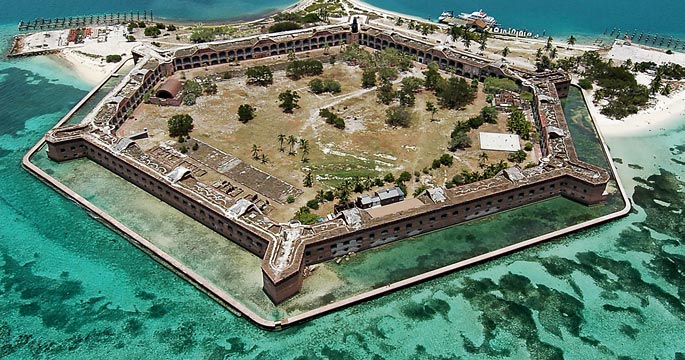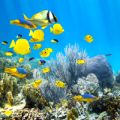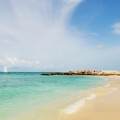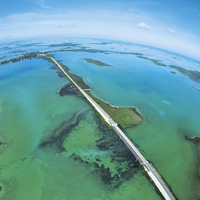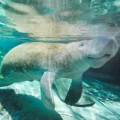A day trip to these often forgotten islands off Key West is full of surprises
Rising with the roosters is not a ritual in Key West, where late-night partying is the norm, but to board the boat to the Dry Tortugas that’s exactly what I have to do. And thanks to the cock-a-doodle-doos of the free roaming “chickens,” as the locals call them, it’s not that difficult to get out of bed. In fact as I make my way to the Key West Bight Ferry Terminal for a 7:15 a.m. check-in, I see the feathered critters scampering about the streets as the sun rises on this Florida island set 90 miles from Cuba.
Although the Dry Tortugas National Park, home to the Civil War-era Fort Jefferson and a coral reef, may not be on your radar, anyone who’s made the trip will definitely tell you to go. A full-day excursion to this chain of seven islands set in the middle of nowhere 70 miles off Key West promises a fun boat ride, a history lesson and a snorkeling adventure, plus breakfast and lunch.
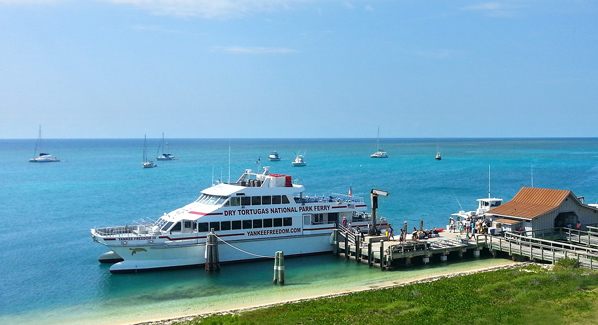
The Yankee Freedom III, a comfy catamaran, docks at Garden Key in the Dry Tortugas. During the six-hour visit passengers snorkel, tour Fort Jefferson and enjoy lunch back on the ferry. Photo: Patricia Letakis
The park’s Yankee Freedom III, a comfy catamaran with an upper sun deck, sets sail at 8 a.m. with about 200 people on board. I claim a spot on the bow where I can clearly see Sunset Key before giving a final wave to Key West’s Mallory Square and a docked cruise ship. As we ply the Gulf of Mexico for deeper waters, Jeff Jannausch, the perky blonde surfer dude guide who welcomed us aboard, is on the microphone giving a play-by-play. We are now 20 miles out and approaching the uninhabited Marquesa Keys—an atoll or group of barrier islands formed in a circle with a natural harbor in the center—known for superb fishing. With the ocean wind snarling my hair, I peer into the clear water looking for sea turtles, then squint as my eyes peel the horizon for a pod of dolphins. Sure enough, there’s a fin in the distance, and passengers from land-locked hometowns go wild.
Two hours later we’re coming up on the Dry Tortugas, which was first named Las Tortugas by Spanish explorer Ponce de Leon in 1513 for its abundance of sea turtles, which he didn’t hesitate to take on board as part of the food supply. Later when no fresh water was discovered, the name was changed to Dry Tortugas to warn seafarers that there was no potable water here. As we approach, the guide is back on the microphone pointing out the highlights of each key we pass. East Key has high elevation perfect for sea turtle nesting. Middle Key is an intertidal island that can go awash during high tide. Hospital Key is where in the 1800s yellow fever patients were quarantined and today is home to a colony of brown booby birds. Garden Key, the largest, is home to the fort and a beach, while the adjacent Bush Key is a nesting site for sooty terns. Long Key has a population of frigate birds, and on the westernmost island, Loggerhead Key, a lighthouse first lit in 1858 still stands.
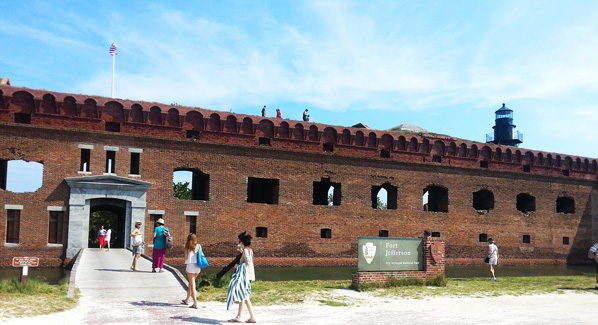
Day trippers explore Fort Jefferson, which is the highlight of a full-day excursion to the Dry Tortugas, a chain of seven islands located 70 miles from Key West. Photo: Patricia Letakis
When it’s time to disembark on Garden Key, passengers can opt to hit the beach and snorkel, do a self-guided tour of historic Fort Jefferson or join the guide on a fort tour. I opt for the latter. As we cross the moat, Jannausch starts talking and I realize that he’s a master storyteller, with a knack for making history fun. I learn that because of the 1803 Louisiana Purchase, the United States needed control of the water route from the Mississippi River to Europe and these islands were safe harbor for U.S. ships. The fort, constructed between1846 and 1875, was built with 16 million two-tone bricks. The first tier was made with bricks from Pensacola, Fla., and after the state joined the Union in 1845, the darker bricks for the top tier were supplied from Maine.
After the walking tour, I head to the snorkel shack and pick up my fins and mask to join the others in the shallow waters, 5 to 15 feet deep, off the beach. Finning along the fort’s wall, I spy a few fish, but soon discover a better spot is the South Coaling Dock Ruins. Weaving my way through these old metal pilings, I see sergeant majors darting about and bright blue and yellow damselfish swimming by and on the sea floor fans and brain corals stand out among the seagrass. Before wrapping my visit I take one last walk on the moat wall surrounding the fort, admiring the bastions, cannons and a massive harbor light above and passing the campground where the real adventurers will spend a night in pitch-black darkness.
At the end of my 4½-hour visit, I rinse off and use the park’s dressing room before boarding. The bar is now open, and cocktail hour is in full swing. After a day of sun and surf, most every passenger finds a comfy spot to doze off as the Yankee Freedom III heads back to Key West.
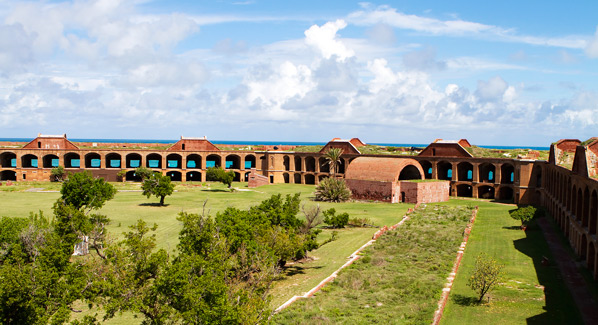
Fort Jefferson, built between 1846 and 1875, is the largest all-masonry fort in the United States and part of the Dry Tortugas National Park. Photo: iStock

